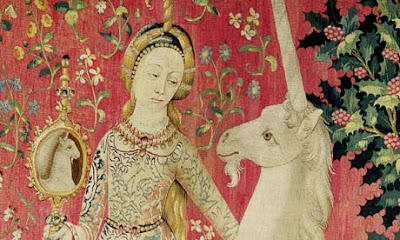“A clever child might argue that the unicorn could exist because it is no more absurd than the narwhal whale. The twisted tusk of the narwhal is what was supposed to grow from the head of the horse known as the unicorn. The centrepiece of a 15th-century Flemish mille-fleurs tapestry in the Victoria and Albert Museum is a unicorn, with a horn exactly like that: a narwhal tusk projects from its forehead, and a heavy tail with flukes, like a whale’s, flourishes above its back. The background is studded with symmetrically placed flowering plants, plus the odd exotic game bird. I would give much to know what the tapestried picture means. Are all the featured creatures imaginary? Is the invented world of human fantasy here presented as superior to reality? Without knowing more about the idea of the unicorn, there is no way I can know what I am looking at.
“A horse with a horn is not a contradiction in terms, unless I define a horse as a hornless creature. It makes no odds that a horse has no need of a horn. The narwhal does nothing with its “horn”, which isn’t even a secondary sexual characteristic because some females have them as well as males. The tusk is actually an overgrown incisor tooth. In theory, horses, too, could start growing a tooth into a tusk and then into a horn. Rhinoceroses have single horns made of modified hair; the mane of a horse could one day develop into a kind of horn. It hasn’t happened – as far as we know – but no evolutionist should discount the possibility…”
The eternal fascination of unicorns, Germaine Greer, The Guardian UK.

